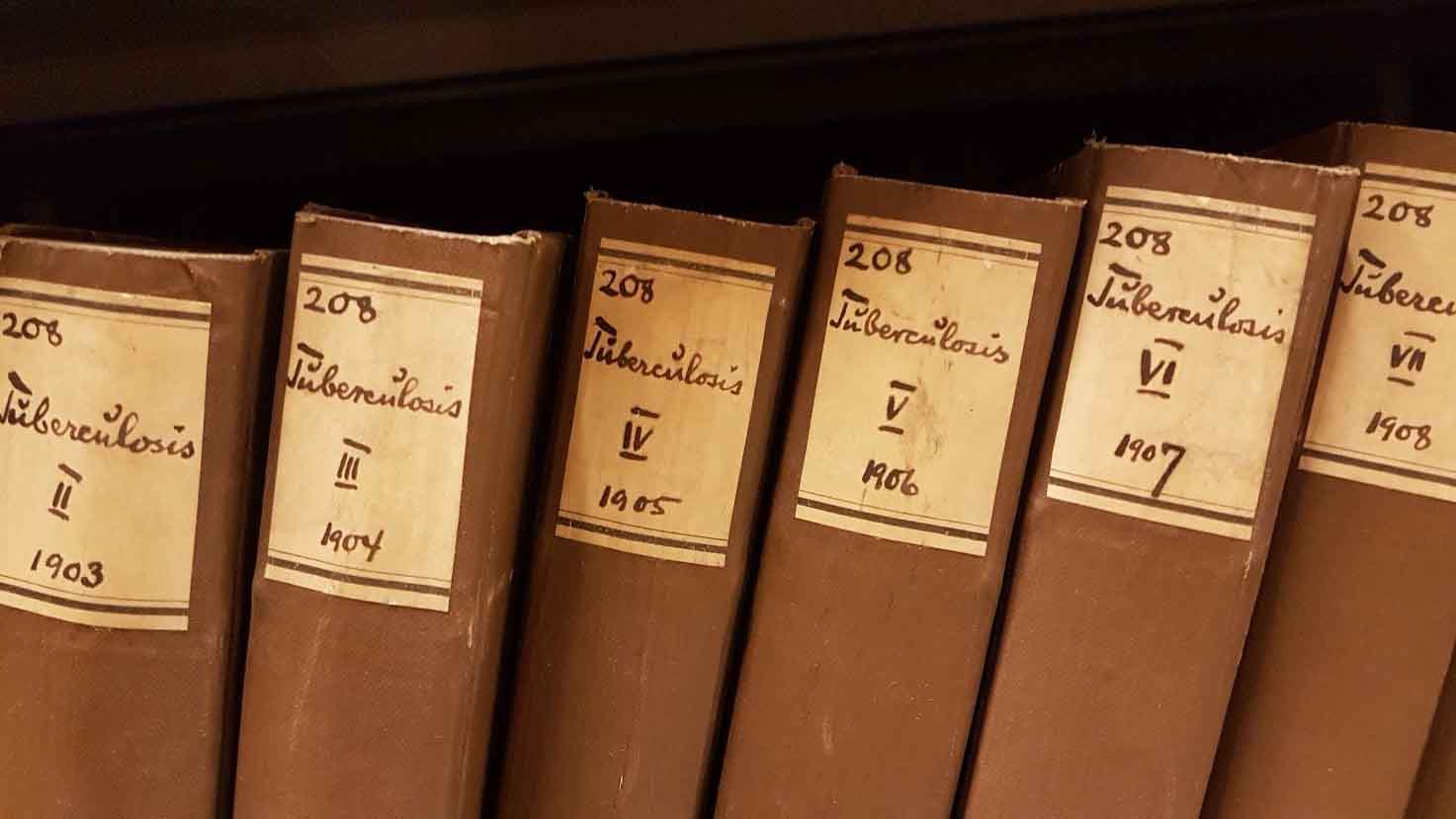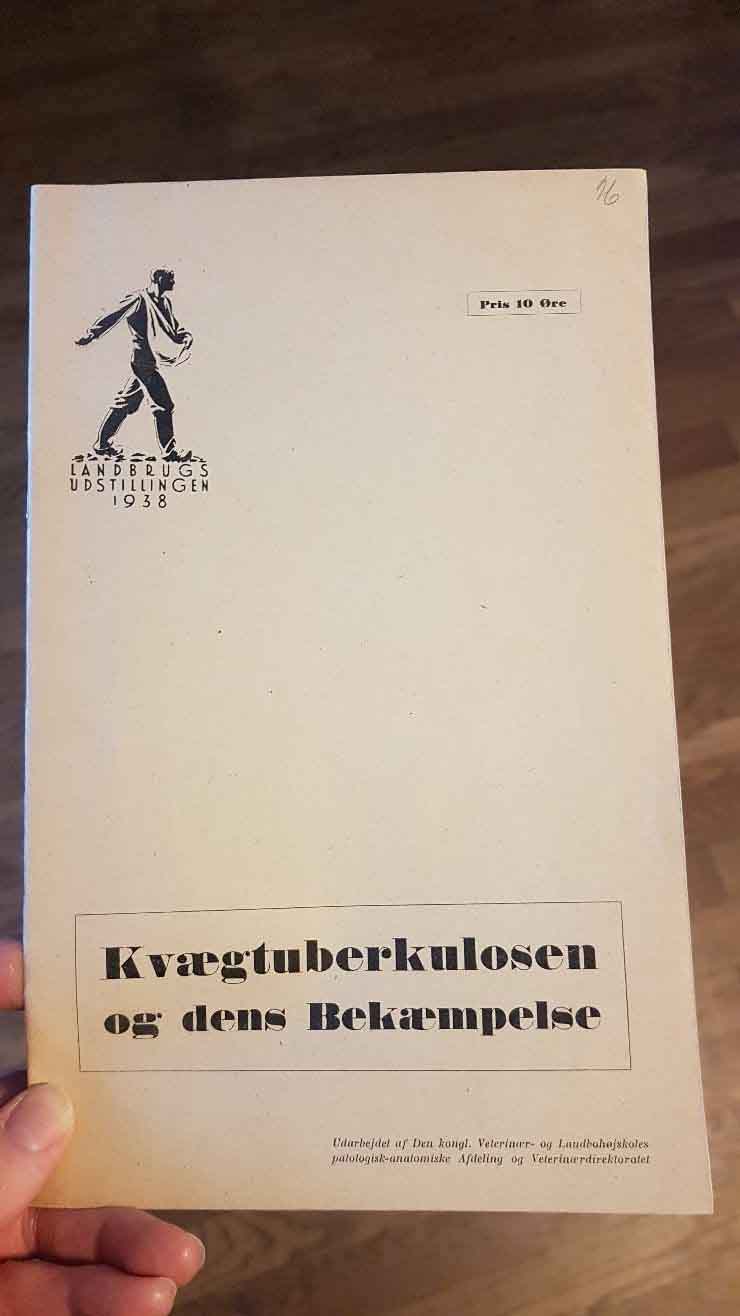Exhibition - When Bovine Tuberculosis came to Denmark
An exhibition at KUB Frederiksberg
In the library’s latest exhibition, we use our cultural heritage to facilitate a small glimpse into the significance of Bovine Tuberculosis on agriculture and general health in Denmark, and how the Agricultural College played a part in controlling the disease through research and teaching.

A zoonosis epidemic long before Corona
Everybody has just lived through, and perhaps we still do, a pandemic caused by a zoonosis – a disease that is transmitted between animals and humans. Covid-19 has impacted our lives substantially the last couple of years, and global measures were implemented to limit the spread of infection. These measures have contributed to limit the consequences of a new disease. However, during the course of history we have been through other epidemics caused by zoonoses.
One of these was Bovine Tuberculosis, reaching Denmark in the 1800s. Differently from today, it took more time to develop an understanding for how the disease worked, could be controlled and eventually eradicated – even though the methods mostly turned out to be the same as today’s.
Bovine Tuberculosis in Denmark
Tuberculosis – caused by the bacteria Mycobacterium tuberculosis with 3 variants: human (typus humanuns), cattle (typus bovinus) and poultry (typus avium) – was of great societal importance in the latter half of the 1800s and up through the first half of the 1900s. Bovine Tuberculosis were officially declared eradicated in 1952, and human tuberculosis were later also considered eradicated in Denmark – although cases of tuberculosis in Denmark still occur.
Tuberculosis in domestic animals spread around 1850 and affected the Danish cattle livestock substantially, thus impacting the dairy and meat production. Bovine Tuberculosis could transmit back and forth between humans and animals and between animals, which in the agricultural industry of the time, with animals and humans in close proximity, supplied numerous opportunities for the disease to spread. As a result, the Agricultural College’s collection of specimens not only include farm animals such as pigs, cattle and hens, but also from dogs and cats.
How easily tuberculosis spread between different animals or between animals and humans varied. It was also different how seriously the disease developed depending on which strain it was – as an example, hens could only be infected by Poultry Tuberculosis, while they in turn could spread the disease to cattle. Cattle infected with Poultry Tuberculosis apparently could not infect other cattle, where a herd of cattle infected with Bovine Tuberculosis easily saw the disease spread and become serious. Therefore, it was necessary to map the complex patterns of transmission. That humans could be infected from walking in an infected cattle herd or by consuming contaminated milk, also posed a significant issue.

Koch, Bang and the tuberculin test
The German doctor Robert Koch (1843-1910) discovered the tuberculosis bacterium in 1882, but it was still unknown how to control the disease. Based on cultures of the tuberculosis bacterium, in 1890 Koch invented tuberculin – a boiled down liquid of tuberculosis bacteria.
Koch dreamt of tuberculin being used for cures, but it instead turned out to be an important tool in controlling the spread of the disease – just as we see today with Covid tests.
The tuberculin liquid could be used as an indicator for tuberculosis infection in humans and animals, when it was injected into an animal or human, or dripped onto skin or in the eye. If the human or animal was infected with tuberculosis, they would react with a fever or swelling of the skin or an inflammation of the eye’s mucous membrane. No reaction to the tuberculin meant there was no infection.
In Denmark, Bernhard Bang (1848-1932), a doctor, veterinarian and professor at the Agricultural College from 1880 to 1919, began using tuberculin tests to determine which animals and livestock were infected.
How to get tuberculosis-free livestock
Bang realised, that one of the ways to accomplish tuberculosis-free livestock was to isolate calves from the herd as soon as possible, and thereby keeping them free of infection. A method that did challenge many in the agricultural industry of the time, as not all farms were large enough to house the separation of herds in this manner, keeping healthy and infected animals from one another. Furthermore, darkness, moisture and manure helped the tuberculosis bacteria survive and thrive, and it was a challenge in many places that the same people could not be around both infected and healthy animals, as this required a greater number of people to tend the animals.
Bang’s specific advice is written down on of our old wall charts (find the original on the first floor):
“Most calves are born healthy. They are infected over time:
1: Through the milk
2: From sharing a stable with tuberculosis-infected cattle.
Tuberculosis can be avoided with certainty by:
1: Giving suckling calves milk from healthy animals or boiled milk, when they are a couple of days old.
2: Ensuring thorough pasteurization of the skimmed milk from the dairy.
3: Keeping the healthy animals in separate rooms from the infected.
 Tuberculous leptomeningitis of the brain and spinal marrow from cattle. B. Bang, 1924.*1
Tuberculous leptomeningitis of the brain and spinal marrow from cattle. B. Bang, 1924.*1
Tuberculous inflammation in brain and spinal meninges in cattle are rare, but they can occur when tubercle bacteria (Mycobacterium bovis) access the central nervous system through blood vessels and lymphatic channels from an area with tuberculosis somewhere else in the organism, often the lungs.
*The pathological collection journal.
The tuberculosis laws
The tuberculosis law was passed in 1898 to control tuberculosis in cattle and to introduce a systematic use of tuberculin tests and veterinary visits to achieve clean herds. Tuberculin associations were formed after 1905, where local farmers of an area organised themselves with a veterinarian to control the tuberculosis in their livestock.
The Bovine Tuberculosis can present itself in different organs, one of the most contagious forms of tuberculosis being tuberculosis of the udder. It infects both animal offspring and humans through the milk. Raw milk is therefore not useable, only boiled milk. Consequently, it became an important aspect of the tuberculosis laws, that all milk returned from the dairy to feed calves and piglets had to be pasteurized.
However, tuberculosis still roamed past the 1900s and up through the 20’s and 30’s at great cost to both dairy plants and slaughterhouses. A new tuberculosis law passed in 1942 that also encompassed pigs and poultry.
And finally in 1952
The measures worked. In 1952, Bovine Tuberculosis was declared eradicated in Denmark, and more than half a century’s continuous struggle against Bovine Tuberculosis had borne fruit.

Dissemination of information in the past – cultural heritage of the present
The impact of the disease was also reflected in the Agricultural College’s teaching and research. The Agricultural College with Bernhard Bang in front was actively trying to control the Bovine Tuberculosis and the large impact of the disease can be seen in the number of wall charts and tuberculosis specimens that were previously used for teaching.
It was also reflected in the vast production of literature and informational material on the subject made during the time in question. This consisted of research dissemination to veterinarians and informational dissemination to the general public, from both the Agricultural College but also the Veterinary Directorate and other public institutions. This is reflected in the library’s collection, among others a large collection of folders on the subject received from the Veterinary Museum, as well as a registry of tuberculosis-free herds from 1936.
The Veterinary Museum is home to The Pathological Collection that contain numerous specimens concerning tuberculosis and display the focus that research and teaching had on the disease.
We have borrowed a range of specimens from The Pathological Collection for the exhibition to supplement the wall charts. Both wall charts and specimens are uniquely produced at the Agricultural College with the object of vocational dissemination to future agriculturalists and veterinarians, who had to work in the reality of agriculture, slaughterhouses and dairy plants and contribute to the control of the disease.

Sources:
Madsen-Mygdal, Th. (1952): Landbrugets Ordborg. Håndbog for den praktiske landmand. 4. udg. Gyldendals Boghandel, Nordisk Forlag. S. 692-698.
Lyne, Olaf (2010): De kæmpede mod tuberkulose – og sejrede. Fra Ribe Amt, 2010, s. 5-14.
Stabsdyrlæge Friis, St. (1908): Den Kongelige Veterinær- og Landbohøjskole 1858-1908. Festskrift ved Højskolens halvtredsindstyveaars jubilæum 24. august 1908. S. 252-295.
